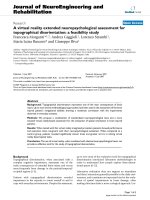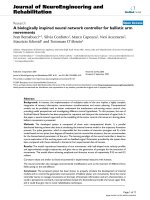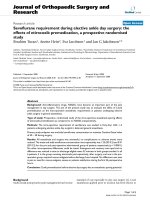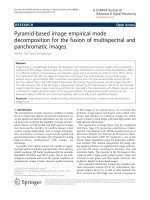Báo cáo hóa học: " A rapid, convenient, solventless green approach for the synthesis of oximes using grindstone chemistry" docx
Bạn đang xem bản rút gọn của tài liệu. Xem và tải ngay bản đầy đủ của tài liệu tại đây (1.27 MB, 6 trang )
ORIGINAL Open Access
A rapid, convenient, solventless green approach for
the synthesis of oximes using grindstone chemistry
Lakhinath Saikia
1
, Jejiron Maheswari Baruah
2
and Ashim Jyoti Thakur
1*
Abstract
Background: Synthesis of oximes is an important reaction in organic chemistry, because these versatile oximes are
used for protection, purification, and characterization of carbonyl compounds. Nitriles, amides via Beckmann
rearrangement, nitro compounds, nitrones, amines, and azaheterocycles can be synthesised from oximes. They also
find applications for selective a-activation. In inorganic chemistry, oximes act as a versatile ligand.
Several procedures for the preparation of oximes exist, but, most of them have not addressed the green chemistry
issue. They are associated with generation of pollutants, requirement of high reaction temperature, low yields, lack of a
generalized procedure, etc. Hence, there is a demand for developing an efficient, convenient, and non-polluting or less
polluting alternative method for the preparation of oximes. In this context, bismuth compounds are very useful as they
are cheap in general, commercially available, air stable crystalline solids, safe, and non-toxic, hence easy to handle.
Results: Carbonyl compounds (aliphatic, heterocyclic, and aromatic) were converted into the corresponding
oximes in excellent yields by simply grinding the reactants at room temperature without using any solvent in the
presence of Bi
2
O
3
. Most importantly, this method minimizes waste disposal proble ms, provides a simple yet
efficient example of unconventional methodology and requires short time.
Conclusions: We have developed a novel, quick, environmentally safe, and clean synthesis of aldoximes and
ketoximes under solvent-free grinding condition.
Graphical abstract: The conversion of carbonyl compounds (aliphatic, heterocyclic, and aromatic) into the
corresponding oximes (up to quantitative yields) was achieved by simply grinding the reactants without using any
solvent in the presence of Bi
2
O
3
. The methodology has the advantages of being rapid, cheap, eco-friendly, easy to
handle, requiring shorter reaction time, and quite general covering all types of aldehydes and ketones.
Interestingly, the reaction never proceeded further neither to provide amide via Beckmann rearrangement nor
nitriles via dehydration. Reusability of Bi
2
O
3
was also checked. Entities such as chloro, nitro, hydroxyl were found to
be inert to the reaction condition.
Keywords: oximes, carbonyl compounds, Bi
2
O
3
, grindstone chemistry, solventless, eco-friendly
* Correspondence:
1
Department of Chemical Sciences, Central University, Tezpur, Napaam,
Tezpur 784028, Assam, India
Full list of author information is available at the end of the article
Saikia et al. Organic and Medicinal Chemistry Letters 2011, 1:12
/>© 2011 Saikia et al; licensee Springer. This is an Open Access article distributed under the terms of the Creative Comm ons Attribution
License ( /by/2.0), which permits unrestricted use, distribution, and reproduc tion in any medium,
provide d the original work is properly cited.
1. Background
Conversion of carbo nyl functionalities into oximes is an
important reaction in organic chemistry. Oximes are
highly crystalline compounds that find appli cations not
only for protection, but also for purification and charac-
terization of carbonyl compounds [1,2].Conversions into
nitriles [3], nitro compounds [4,5], nitrones [6], amines
[7], and synthesis of azaheterocycles [8] are some of the
synthetic applications of oximes. They are also useful
for selective a-activat ion [9] and are extensively used as
intermediates for the preparation of amides by the Beck-
mann rearrangement [10,11] and fungicides and herbi-
cides [12]. In inorganic chemistry, oximes act as a
versatile ligand.
Classically, oximes are prepared [2] by refluxing an
alcoholic solution of a carbonyl compound with hydro-
xylamine hydrochloride and pyridine. The method has
multiple drawbacks such as low yields, long reaction
time, toxicity of pyridine , and effluent pollution caused
by the use of organic solvent. In recent times, solvent-
free reactions have drawn considerable attention a nd
popularity [13,14], not only from an environmental
point of view , but also for synthetic advantages in terms
of yield, se lectivity, and simplicity of the reaction proce-
dure. Since chemical industry deals with larger quantity
of materials, these factors are particularly very important
therein. Over the years, many reagents and catalysts
have been developed for the synthe sis of oximes. Basic
aluminia [15], CaO [16], and TiO
2
/(SO
4
2-
) [17] coupled
with microwa ve irradiatio n under solvent-free condition
have been claimed to be efficient methods for the pre-
paration of oximes. Hashem Sharghi and Hosseini [18]
described a solventless reaction protocol for synthesizing
aldoximes from corresponding aldehydes using ZnO as
catalyst at 80°C. Interestingly, they obtained Beckmann
rearrangement product at higher temperatures (140-170°
C). More recently, conversion of carbonyl c ompounds
to oximes in aqueous biphasic medium and ionic liquid/
water biphasic system [19,20] has been reported. How-
ever, problems of generation of polluting HCl, high
reaction temperature, occasionally low yields, and lack
of a generalized procedure covering all types of alde-
hydes and ketones still present. Consequently, there is a
demand for developing an efficient, convenient, and
non-polluting or less polluting alternative method for
the preparation o f oximes. In this context, because o f
the rich chemistry of bismuth compounds [21-25], we
became interested therein. Bismuth compounds are gen-
erally cheap, commercially available, air stable crystalline
solids, safe, and non-toxic, hence easy to handle. Their
Lewis acidity is also well known [26,27]. Most bismuth
(III) compounds have an LD
50
value which is compar-
able to or even less than that of NaCl [28].
In continuation to our interest in protection and
deprotection chemistry [29,30], we have developed a
novel, quick, environmentally safe, and clean synthesis
of aldoximes and ketoximes under grinding condition
(Scheme 1) uti lizing pestle and mortar under solvent-
free condition. The method makes use of local heat gen-
erated by simply grinding the reactants and catalyzed by
cheap and commerc ially available Bi
2
O
3
for driving th e
chemical reaction at room temperature. The work up is
easy and furnished the oximes in excellent yields. Most
importantly, this method minimizes waste disposal pro-
blems and provides a simple yet efficient example of
unconventional methodology, which is equally effective
for all types of aldehydes and ketones. Earlier reports
[15,31] of similar type restricted their utility in carbonyl
compounds (alicyclic and aliphatic) and aromatic alde-
hydes only and aromatic ketoximes were not obtained.
In those reports, for ketoxime synthesis, microwave irra-
diation or addition of some other additives was neces-
sary. In this regard, our method is superior, quite
general, and versatile.
2. Results and discussion
In the present solvent-free method, the effectiveness of
Bi
2
O
3
in oxime synthesis (see Scheme 1) under grinding
condition is demonstrated using a b road spectrum of
aldehydes and ketones with h ydroxylamine hydrochlor-
ide in the absence of a base or any other additives. To
search for the best reaction condition for oximation
using easily available bismuth compound s, a set of reac-
tions have been carried out using p-chlorobenzaldehyde
and hydroxylamine hydrochloride as substrates under
various reaction conditions at consta nt catalyst (Bi
2
O
3
and BiOCl) loading (50 mol% with re spect to substrate).
Figure 1 summarizes the results, which clearly shows
that the Bi
2
O
3
under solvent-free grinding c ondition is
the most effective.
After surveying a series of reaction conditions, the
optimized results are summarized in Table 1. Aromatic,
aliphatic, heterocyclic, and a,b-unsaturated aldehydes
were converted to the corresponding oximes in almost
Scheme 1 Synthesis of aldoximes and ketoximes.
Saikia et al. Organic and Medicinal Chemistry Letters 2011, 1:12
/>Page 2 of 6
quantitative yields within very short time (1.5-3 min,
entries 1a-k, Table 1). Cinnamaldehyde (entry 1j, Table
1) was smoothly converted to cinnamal dehyde oxime
without any rearrangeme nt of a ,b-double bond. For
ketones (acyclic and cyclic), however, reactions were
comparatively difficult and took a little longer time (5.5-
20 min, entries 1l-q, Table 1). It was interesting to note
that the less reactive benzophenone al so condensed with
hyd roxylamine hydrochloride in 60% yield only that too
requiring longer time, i.e., 20 min (entry 1q, Table 1).
5a-Pregn-16-en-3a-ol-20-one acetate o xime (entry 1l,
Table 1) was obtained in 88% yield within 6 min. The
unreacted materials were recovered from the reaction
mixture. No observable difference in reactivity exerted
by -NO
2
group at m-orp-position was noticed (entries
1b and c, Table 1), being yields and reaction times were
almost same. Entities such as chloro, nitro, hydroxyl
were found to be inert t o the reaction condition. The
products were identified by their spectral (
1
HNMR,
13
C
NMR, IR spectra) data, physical data (melting point, ele-
mental analysis), and comparison with authentic ones.
IR spectra supported this obse rvation as no peak was
observed around 2200 cm
-1
characteristic of the -C≡N
group. However, appearance of peaks around 3200-3450
and 1600-1680 cm
-1
are indicative of -OH and >C = N-
groups, respectively. In
1
H NMR spectra, the -OH signal
of oximes appeared within δ = 8.0-10.00 ppm as a broad
singlet (characteristic signal) that was exchangeable with
D
2
O. It was very appealing that in these reactions
neither the dehydration product, nitriles, nor the
amides, via Beckmann rearrangement were observed.
The reaction was very clean and no other product was
observed.
To evaluate the synergy between rate, yield, and
Bi
2
O
3
loading in this reaction, several experiments
were carried out. In a pilot experiment, the reaction
was found to proceed poorly in the absence of Bi
2
O
3
.
As far as Bi
2
O
3
loading is concerned, 60 mol% of the
catalyst with respect to the substrate was the optimum
one (Table 2). An increase in Bi
2
O
3
loading did not
improve the yield as wel l as no change in reaction
time was observed. Howeve r, a d ecrease in Bi
2
O
3
load-
ing appreciably decreased the rate and yield of the
reaction.
We have also checked the reusability of the catalyst
using the recovered Bi
2
O
3
from the reaction. It is
observed that recovered catalyst could be satisfactorily
used for the second run, whereas, third run of the
recovered catalyst leads to poor yield and longer reac-
tion time (Table 3). The surface areas of the fresh as
well as the recovered ca talyst after the third r un in the
reaction were determined in a surface area and pore size
analyzer and found to be 5.21 and 37.106 m
2
/g, respec-
tively. The average particle diameters of the fre sh as
well as the recovered ca talyst after the third r un in the
reaction were calculated out from these measured sur-
face areas and were found to be 129.396 and 18.168 nm,
respectively. The increase in granularity of the catalyst
after reuse is obvious since it was grounded. However,
the decrease in efficiency of the catalyst after the third
Figure 1 Effect of reaction conditions in yields.
Saikia et al. Organic and Medicinal Chemistry Letters 2011, 1:12
/>Page 3 of 6
Table 1 Preparation of aldoximes and ketoximes 2a
Entry Substrate 1 Product 2 Time (min) Isolated yield (%) Mp/°C (Lit.)
a
1.5 95 -(35)
b
b 2 96 105 (107)
b
c
2 96 130 (133)
b
d 2 95 120 (122)
b
e
2 >98 75 (80)
b
f
3 95 74 (72)
b
g
2.5 98 128 (132)
b
h
2 95 72 (-)
c
i
2 >98 128 (132-136)
b
j
2 >98 135 (139)
b
k
6 88 197 (195.5-198)
b
l 3 96 -(52)
b
m 5.5 92 -(57)
b
n 6 95 86 (91)
b
o
7 >98 56 (59)
b
p
6.5 >98 86 (88)
b
q
20 60 140 (144)
b
a
All compounds were characterized on the basis of IR,
1
H and
13
C NMR spectral data, Mass spectrometry data and m
p
.
b
(i) Furniss BS, Hannaford AJ, Smith PWG, Tatchell AR (2008) Vogel’s textbook of practical organic chemistry, 5th edn. Pearson Education, Dorling Kindersley
(India). (ii) Alfa-Aesar Research Chemicals, Metals and Materials catalogue, 2008-2009.
c
Not found in the literature.
Saikia et al. Organic and Medicinal Chemistry Letters 2011, 1:12
/>Page 4 of 6
run might be due to the loss of active sites of the
catalyst.
3. Conclusions
To the best of our knowledge, Bi
2
O
3
has never been
used in the synthesis of oximes earlier. In conclusion,
the reported procedure is an interesting, extremely sim-
ple, suitable, fast, efficient, and novel method for the
preparation of oximes. The methodology also offers che-
mical, economical, and environmental advantages. On
the other hand, Bi
2
O
3
is remarkably easier to use, non-
hazardous, inexpensive and work under mild neutral
conditions [32,33].
4. Experimental
Melting points were determined on a Büchi 504 appara-
tus and were uncorrected. IR spectra were recorded in
KBr pallets on a Nicolet (Impact 410) FT-IR spectro-
photometer.
1
HNMRand
13
C NMR spectra were
recorded on a JNM ECS 400 MHz FT-NMR (JEOL)
spectrophoto meter with TMS as the internal standard.
Mass spectra were recorded on a Waters Q-TOF Pre-
mier & Aquity UPLC spectrometer. Surface area of the
catalyst before and after use in the reaction was mea-
sured using surface area & pore size analyzer (NOVA
1000e, Quanta chrome Instruments). All the chemicals
were used as-received.
5. Methods
5.1. Typical procedure for the formation of oxime 2
A mixture of aldehyde/ketone 1 (1 mmol), hydroxyla-
mine hydrochloride (1.2 mmol), a nd Bi
2
O
3
(0.6 mmol)
was grounded in a mortar with a pestle for the required
period of time. On completion of the reaction as
monitored by TLC, ethyl acetate (2 × 10 mL) was added
to the reaction mixture and filtered to separate the
Bi
2
O
3
. The filtrate was concentrated down to approx. 6
mL, then added water to it when product precipitated
out from the solution. The precipitate was filtered out
and dried in high vacuum to furnish the pure oxime 2 in
60-98% yield.
Abbreviations
IR: infrared; LD
50
: lethal dose that kills half (50%) of the animals tested; NMR:
nuclear magnetic resonance.
Acknowledgements
The authors are very grateful to the Council of Scientific and Industrial
Research (CSIR), New Delhi, India, for financial support to the project CSIR
(01(2147)/07/EMR-II).
Author details
1
Department of Chemical Sciences, Central University, Tezpur, Napaam,
Tezpur 784028, Assam, India
2
Chembiotek, Kolkata, India, C/o TCG
Lifesciences Ltd., Block BN, Sector V, Salt Lake City, Kolkata 700 091, India
Competing interests
The authors declare that they have no competing interests.
Received: 31 March 2011 Accepted: 4 October 2011
Published: 4 October 2011
References
1. Sandier SR, Karo W (1989) Organic functional group preparations, 2nd edn.
Academic Press: San Diego, pp 431–476
2. Greene TW, Wuts PGM (1999) Protective groups in organic synthesis, 3rd
edn. Wiley: Toronto, pp 355–358
3. Dewan SK, Singh R, Kumar A (2006) One pot synthesis of nitriles from
aldehydes and hydroxylamine hydrochloride using sodium sulphate (anhyd)
and sodium bicarbonate in dry media under microwave irradiation. Arkivoc
ii: 41–44
4. Dave PR, Forshar F (1996) Facile preparation of 3,7-diazabicyclo[3.3.0]octane
and 3,7,10-triheterocyclic[3.3.3]propellane ring systems from 1,5-
diazacyclooctane-3,7-derivatives. J Org Chem 61(25):8897–8903. doi:10.1021/
jo9614755.
5. Ballistreni FP, Barbuzzi E, Tomaselli GA, Toscano RM (1996) Useful oxidation
procedure of oximes to nitro compounds with Benz-Mo in acetonitrile.
Synletters 11:1093–1094
6. Smith PAS, Gloyer SE (1975) Oxidation of dibenzylhydroxylamines to
nitrones. Effects of structure and oxidizing agent on composition of the
products. J Org Chem 40(17):2508–2512. doi:10.1021/jo00905a019.
7. Negi S, Matsukura M, Mizuno M, Miyake K, Minami N (1996) Synthesis of
(2R)-1-(4-Chloro-2-pyridyl)-2-(2-pyridyl)ethylamine: a selective oxime
reduction and crystallization-induced asymmetric transformation. Synthesis
8:991–996
8. Narasaka K (2003) Synthesis of azaheterocycles from oxime derivatives. Pure
Appl Chem 75(1):19–28. doi:10.1351/pac200375010019.
9. Whitesell JK, Whitesell MA (1983) Alkylation of ketones and aldehydes via
their nitrogen derivatives. Synthesis 7:517 –536
10. Ramalingan C, Park Y-T (2007) Mercury-catalyzed rearrangement of
ketoximes into amides and lactams in acetonitrile. J Org Chem
72:4536–4538. doi:10.1021/jo070297k.
11. Furuya Y, Ishihara K, Yamamoto H (2005) Cyanuric chloride as a mild and
active Beckmann rearrangement catalyst. J Am Chem Soc 127:11240–11241.
doi:10.1021/ja053441x.
12. Song BA, Liu XH, Yang S, Hu DY, Jin LH, Zhang YT (2005) Recent advance
in synthesis and biological activity of oxime derivatives. Chin J Org Chem
25(5):507–525
13. Metzger JO (1998) Solvent-free organic syntheses. Angew Chem Int Ed
37:2975–2978. doi:10.1002/(SICI)1521-3773(19981116)37:213.0.CO;2-A.
14. Tanaka K, Toda F (2000) Solvent-free organic synthesis. Chem Rev
100:1025–1074. doi:10.1021/cr940089p.
Table 2 Optimization of catalyst loading in preparation
of 2b
Entry Catalyst loading (mol%) Time Yield (%)
1No 2h15
2 20 30 min 48
3 30 30 min 57
4 40 30 min 70
5 50 15 min 90
6 60 2 min 96
7 70 2 mins 96
Table 3 Reusability of Bi
2
O
3
in the preparation of 2b
using 60 mol% of the catalyst
Entry Run number Time Yield (%)
11 296
22 887
3 3 20 52
Saikia et al. Organic and Medicinal Chemistry Letters 2011, 1:12
/>Page 5 of 6
15. Kad GL, Bhandari M, Kaur J, Rathee R, Singh J (2001) Solventless preparation
of oximes in the solid state and via microwave irradiation. Green Chem
3:275–277. doi:10.1039/b107356g.
16. Sharjhi H, Sarvari MH (2000) A mild and versatile method for the
preparation of oximes by use of calcium oxide. J Chem Res (S) 1:24–25
17. Guo JJ, Jin TS, Zhang SL, Li TS (2001) TiO
2
/SO
4
2-
: an efficient and
convenient catalyst for preparation of aromatic oximes. Green Chem
3:193–195. doi:10.1039/b102067f.
18. Sharghi H, Hosseini M (2002) Solvent-free and one-step Beckmann
rearrangement of ketones and aldehydes by Zinc oxide. Synthesis
8:1057–1059
19. Sloboda-Rozner D, Neumann R (2006) Aqueous biphasic catalysis with
polyoxometalates: oximation of ketones and aldehydes with aqueous
ammonia and hydrogen peroxide. Green Chem 8:679–681. doi:10.1039/
b604837d.
20. Luo HM, Li YQ, Zheng WJ (2005) A novel ionic liquid/water biphasic system
for the preparation of oximes. Chin Chem Lett 16(7):906–908
21. Suzuki H, Ikegami T, Matano Y (1997) Bismuth in organic transformations.
Synthesis 3:249–267
22. Leonard NM, Wieland LC, Mohan RS (2002) Applications of bismuth(III)
compounds in organic synthesis. Tetrahedron 58:8373–8397. doi:10.1016/
S0040-4020(02)01000-1.
23. Gaspard-Iloughmane H, Le Roux C (2004) Bismuth(III) triflate in organic
synthesis. Eur J Org Chem 12:2517–2532
24. Aggen DH, Arnold JN, Hayes PD, Smoter NJ, Mohan RS (2004) Bismuth
compounds in organic synthesis. Bismuth nitrate catalyzed chemoselective
synthesis of acylals from aromatic aldehydes. Tetrahedron 60:3675–3679.
doi:10.1016/j.tet.2004.02.046.
25. Iglesias L, Aguilar C, Bandyopadhyay D, Banik BK (2010) A new Bismuth
nitrate-catalysed electrophilic substitution of Indoles with carbonyl
compounds under solevnt-free conditions. Synth Commun 40:3678–3682.
doi:10.1080/00397910903531631.
26. Salvador JAR, Ppinto RMA, Silvestre SM (2009) Recent advances of bismuth
(III) salts in organic chemistry: application to the synthesis of heterocycles of
pharmaceutical interest. Curr Org Synth 6:426–470. doi:10.2174/
157017909789108701.
27. Salvador JAR, Ppinto RMA, Silvestre SM (2009) Recent advances of bismuth
(III) salts in organic chemistry: application to the synthesis of aliphatics,
alicyclics, aromatics, amino acids and peptides, terpenes and steroids of
pharmaceutical interest. Mini Rev Org Chem 6:241–274. doi:10.2174/
157019309789371587.
28. Suzuki H, Matano Y (eds) (2001) Organobismuth chemistry. Elsevier,
Amsterdam
29. Das S, Bora R, Devi RR, Thakur AJ (2008) Molecular iodine in protection and
deprotection chemistry. Synletters 18:2741–2762
30. Saikia L, Das S, Thakur AJ (2011) Deprotection chemistry mediated by
ZrOCl
2
.8H
2
O: an efficient, mild and green method for the conversion of
oximes to carbonyl compounds in aqueous acetone. Synth Commun
41:1071–1076. doi:10.1080/00397911003797783.
31. Damljanovic I, Vukicevic M, Vukicevic RD (2006) A simple synthesis of
oximes. Monatsh Chem 137:301–305. doi:10.1007/s00706-005-0427-3.
32. Irwing-Sax N, Bewis RJ (1989) Dangerous properties of industrial materials.
Van Nostrand Reinhold, New York, pp 283–284, 522-523
33. Reglinski J, Norman NC, (eds) (1998) Chemistry of arsenic, antimony and
bismuth. Blackie Academic and Professional, New York, pp 403–440
doi:10.1186/2191-2858-1-12
Cite this article as: Saikia et al.: A rapid, convenient, solventless green
approach for the synthesis of oximes using grindstone chemistry. Organic
and Medicinal Chemistry Letters 2011 1:12.
Submit your manuscript to a
journal and benefi t from:
7 Convenient online submission
7 Rigorous peer review
7 Immediate publication on acceptance
7 Open access: articles freely available online
7 High visibility within the fi eld
7 Retaining the copyright to your article
Submit your next manuscript at 7 springeropen.com
Saikia et al. Organic and Medicinal Chemistry Letters 2011, 1:12
/>Page 6 of 6









